In today’s connected world, lighting has become more than just a functional necessity, it’s part of a smarter, more personalized lifestyle. If you’ve ever wondered, how do smart light bulbs work, the answer lies in their seamless blend of LED efficiency and modern wireless technology. These innovative bulbs are equipped with microcontrollers and communication chips that let you control lighting through smartphone apps, voice assistants, or automated systems. Whether it’s dimming your lights from the couch or scheduling them to turn off when you leave for work, smart bulbs make it all effortless.
Video explaning how do you need smart home!
Connected via Wi-Fi, Bluetooth, Zigbee, or Z-Wave, they offer a level of control that standard bulbs simply can’t match. Many models also feature color customization, scheduling, motion sensor triggers, and energy usage tracking.
At NaturalLightLiving.com, we break down the technology behind these bulbs and explore how they can add security, efficiency, and ambiance to your home. Ready to upgrade your lighting experience? Let’s dive into how these clever bulbs actually work.
Key Takeaways
- Smart bulbs use LEDs and microcontrollers to offer energy-efficient, programmable lighting.
- Wireless communication (Wi-Fi, Zigbee, Bluetooth, Z-Wave) enables remote control and smart home integration.
- Smartphone and voice assistant compatibility allows easy control, scheduling, and customization.
- Features like color tuning, dimming, and automation offer convenience, comfort, and ambiance.
- Scheduling and remote access features enhance energy savings and home security.
Core Functionality of Smart Light Bulbs
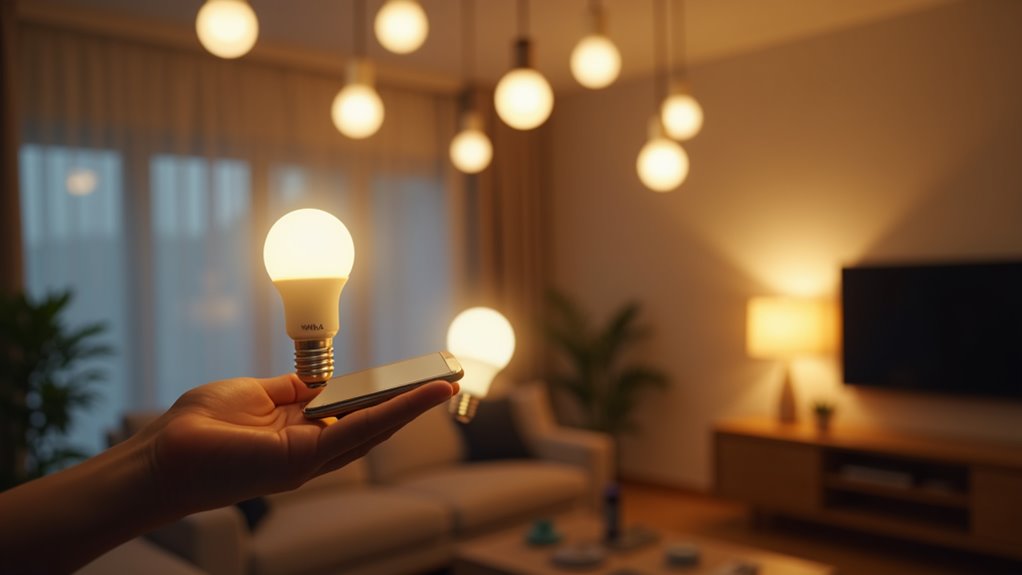
Smart light bulbs are revolutionizing modern lighting through their advanced features and intelligent design. At their core, these bulbs utilize LED technology, which enhances energy consumption efficiency compared to traditional lighting. Internal components, including a microcontroller and wireless communication chip, facilitate smart bulb automation, allowing users to control light output remotely.
This includes turning lights on and off, dimming, and even changing colors through smartphone apps or voice commands. The implementation of scheduling and motion sensors further optimizes energy consumption by ensuring bulbs illuminate only when necessary.
Additionally, the incorporation of power management systems ensures these efficient designs last longer, contributing to both practical and sustainable lighting solutions for households and businesses alike. Smart lights contain a chip for wireless communication, enabling seamless connectivity with home networks and devices. Plastic components protect the internal structure of smart bulbs, ensuring their durability and longevity.
Connectivity Methods for Smart Bulbs
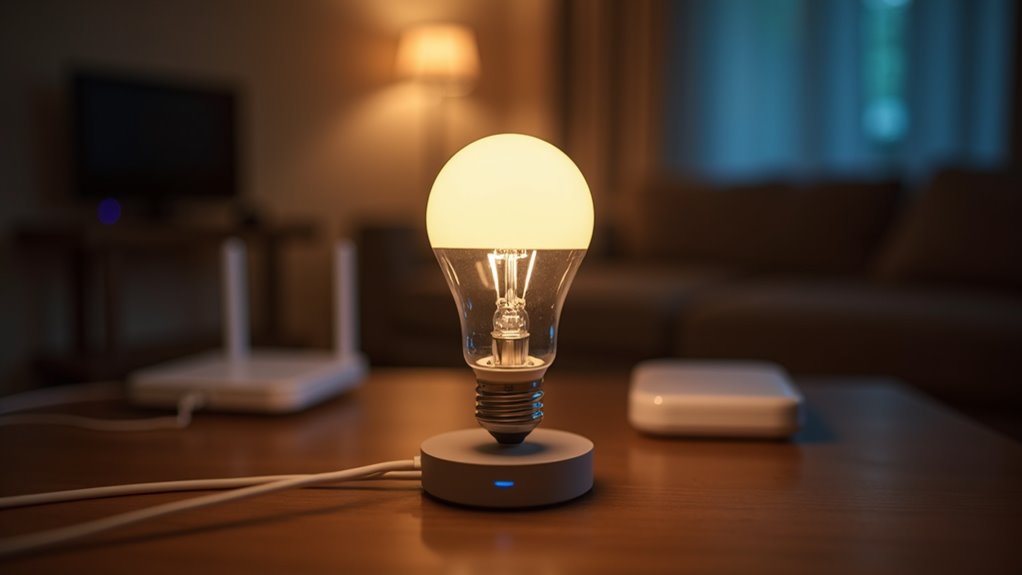
As technology evolves, various connectivity methods for intelligent lighting solutions have emerged, enabling users to harness the full potential of smart bulbs.
Each method has unique characteristics that cater to different user needs:
Various connectivity methods offer distinct advantages, ensuring users can select the best fit for their smart home requirements.
- Wi-Fi: Directly connects to home networks, though it faces Wi-Fi limitations and potential congestion.
- Bluetooth: Offers simple control but has a limited Bluetooth range, making it less ideal for larger spaces.
- Zigbee: Boasts strong Zigbee security and low-power consumption, yet requires a compatible hub for connectivity.
- Z-Wave: Known for Z-Wave interoperability, it operates on a less congested frequency, improving reliability.
- Matter and Thread: Enhance compatibility across devices, with Thread advantages like low power and improved communication speed.
These connectivity methods allow users to choose based on their smart home needs.
Internal Components of Smart Bulbs
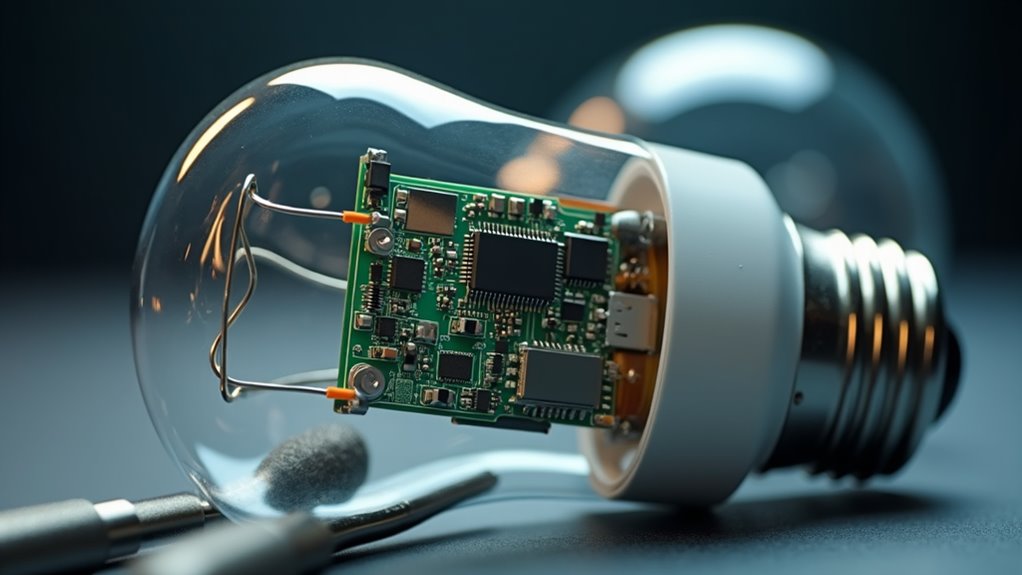
The internal components of smart bulbs work in harmony to provide advanced lighting solutions tailored to user preferences. At the core lies LED technology, which delivers energy-efficient illumination.
These LEDs, mounted on a compact circuit board, can emit various colors and temperature of light. The microcontroller functions as the brain of the bulb, executing firmware commands for features like dimming and color adjustment.
A well-designed LED driver ensures optimal power regulation, converting AC to the necessary DC voltage while safeguarding LEDs from fluctuations.
Housing materials, typically plastic, house the internal elements, while an aluminum heat sink facilitates thermal management, prolonging LED lifespan.
This intricate design underscores the innovation behind energy-efficient smart lighting.
Control and Customization Options
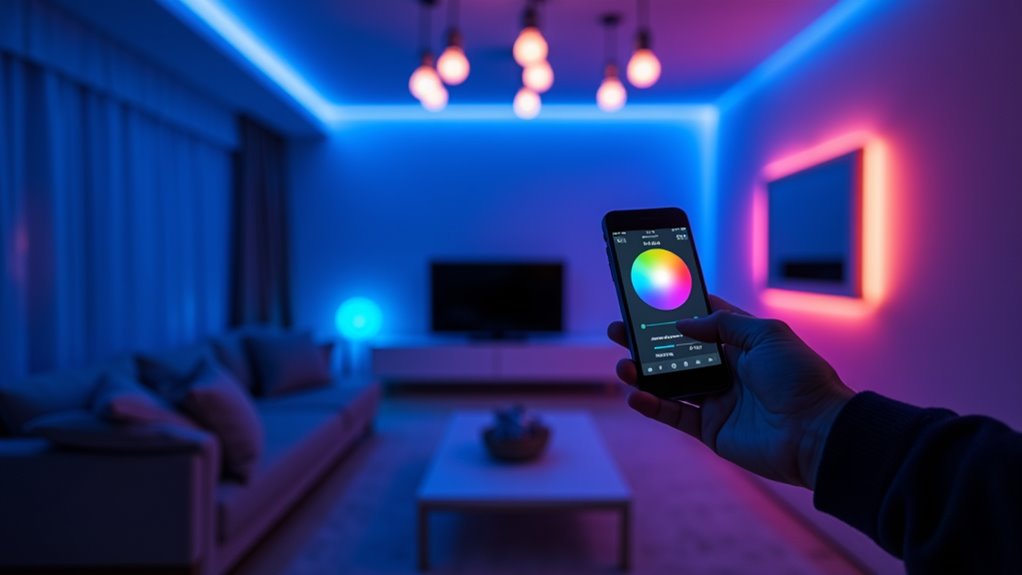
Harnessing technology, modern light bulbs provide users with a range of control and customization options that enhance both convenience and ambiance.
Smart light bulbs can be effortlessly managed through dedicated smartphone apps or voice integration, allowing for hands-free operation.
Smart light bulbs offer seamless control via smartphone apps or voice commands, ensuring hands-free convenience and effortless operation.
- Remote control of lights from anywhere with internet access
- Adjustable brightness and a spectrum of up to 16 million colors
- Scheduling features for automated on/off functions
- Grouping options to synchronize multiple bulbs for cohesive lighting
- Energy usage monitoring to help optimize consumption
These features not only enhance user experience but also promote energy efficiency, making smart bulbs a practical choice for modern homes.
Setup Process for Smart Bulbs
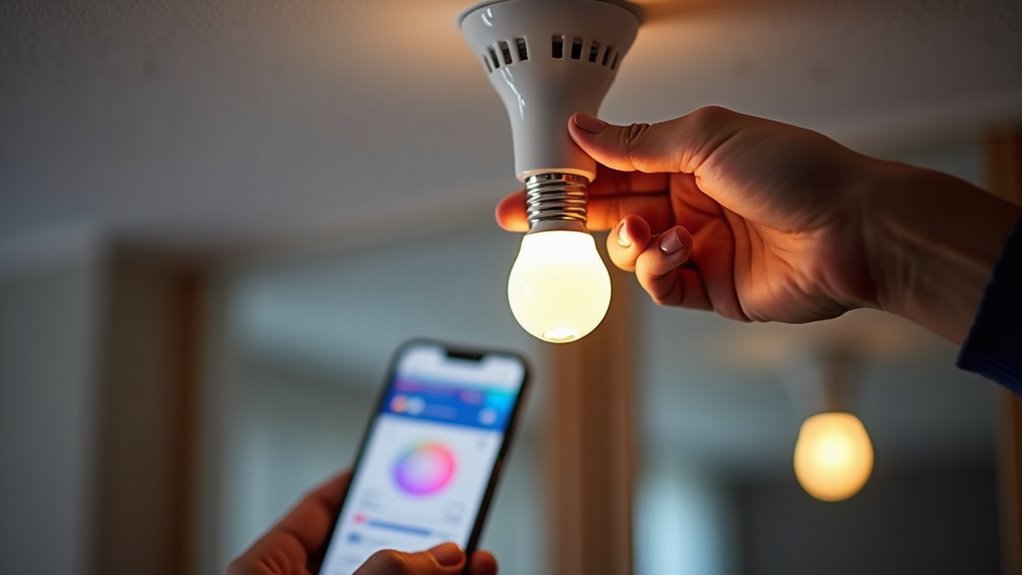
The setup process for smart bulbs involves several key steps that ensure proper functionality.
First, users must gather the necessary equipment, including a compatible smartphone and a stable Wi-Fi network.
Following this, the installation steps and app pairing process facilitate a seamless integration of the smart bulb into the home environment.
Required Equipment Overview
Setting up smart light bulbs requires a few essential components to ensure a seamless experience. Understanding these installation essentials and user requirements will simplify the process.
- Smart LED bulbs in various shapes and sizes.
- Stable 2.4GHz Wi-Fi network for reliable connectivity.
- Smartphone or tablet to download the controlling app.
- Compatible smart hub for certain brands or multi-device setups.
- Voice assistant device for hands-free control capabilities.
These components form the foundation for interacting with smart bulbs effectively. Each plays a crucial role in not only installing the bulbs but also maximizing their functionality and convenience in everyday life.
Properly equipping oneself with these items guarantees a smooth transition into smart lighting solutions.
Installation Steps
Installing smart light bulbs involves a series of straightforward steps that can enhance any home’s lighting experience.
First, it is crucial to ensure bulb compatibility by verifying that the smart bulb’s base type matches the existing fixture.
Before starting installation, the power should be turned off, preferably at the circuit breaker for added safety.
After removing the old bulb, the new smart bulb can be securely installed in the socket.
One common installation challenge is initiating pairing mode, which often requires a specific power cycling sequence.
Once the bulb is in place, turning the power back on may make it illuminate or flash, indicating it is operational.
Proper checks follow to ensure functionality and Wi-Fi connection stability.
App Pairing Process
After successfully installing the smart light bulb, the next step involves pairing it with the dedicated mobile application. The app setup begins with essential preparations to ensure device discovery and connection.
Users must follow these steps:
- Download the manufacturer’s app from the App Store or Google Play Store.
- Create an account if necessary, often requiring email verification.
- Power on the smart bulb and place it within reach for QR code scanning.
- Enable Bluetooth and location services on the smartphone.
- Connect the smartphone to a 2.4 GHz Wi-Fi network.
Once the bulb is in pairing mode, the app will detect it, allowing users to complete the connection by entering Wi-Fi credentials, ensuring seamless functionality.
Advanced Features and Benefits of Smart Light Bulbs
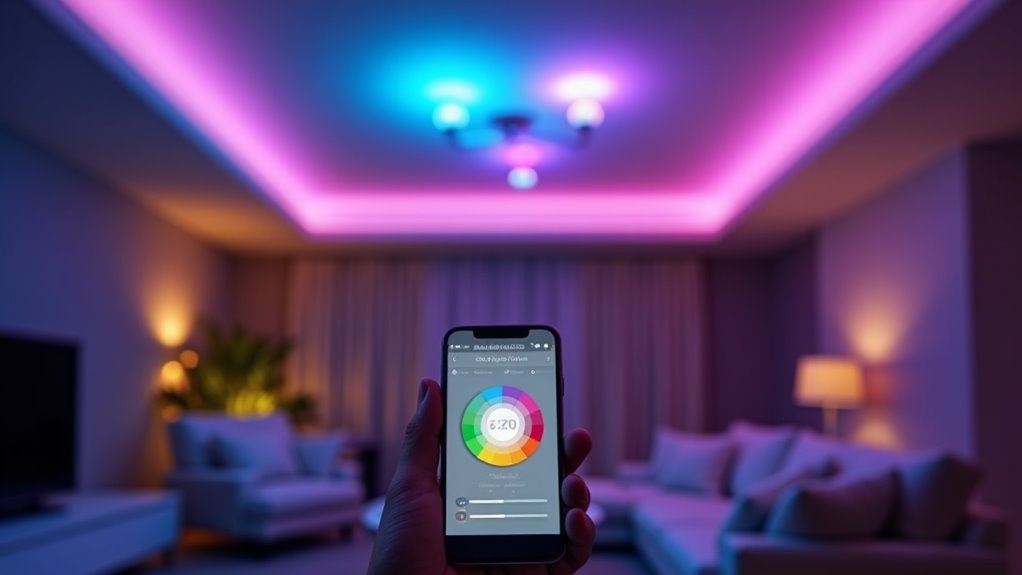
Smart light bulbs offer a remarkable array of advanced features that enhance both user experience and home automation. Users can enjoy enhanced customization with millions of colors, adjustable brightness, and color temperatures that promote better sleep.
Smart energy management is achieved through efficient LED technology, reducing energy consumption significantly compared to traditional bulbs.
These devices facilitate personalized automation, allowing for programmed schedules, motion sensor activation, and geofencing to match daily routines. Integration with smart home ecosystems permits voice control and seamless operation alongside other smart devices.
Enhanced safety features, such as remote control and scheduling for simulated occupancy, further bolster security. Overall, smart light bulbs merge functionality with innovation, delivering comfort, efficiency, and peace of mind.
Concluding
Smart light bulbs are more than just a modern gadget, they’re a gateway to greater home comfort, convenience, and energy efficiency. By combining LED technology with wireless communication, they offer a dynamic range of features that adapt to your lifestyle. Whether you’re automating your lights for security while you’re away or setting the perfect mood for movie night with a voice command, smart bulbs make lighting both intelligent and intuitive.
Choosing the right smart bulb depends on your connectivity preferences and desired features, but even basic models offer significant upgrades over traditional lighting. With flexible brightness, color customization, scheduling, and remote control, these bulbs give you power over your environment like never before.
At NaturalLightLiving.com, we help you make sense of the smart home revolution starting with smarter lighting. Explore our guides and product reviews to find the best smart bulbs for your home and take the first step toward lighting that truly works for you.


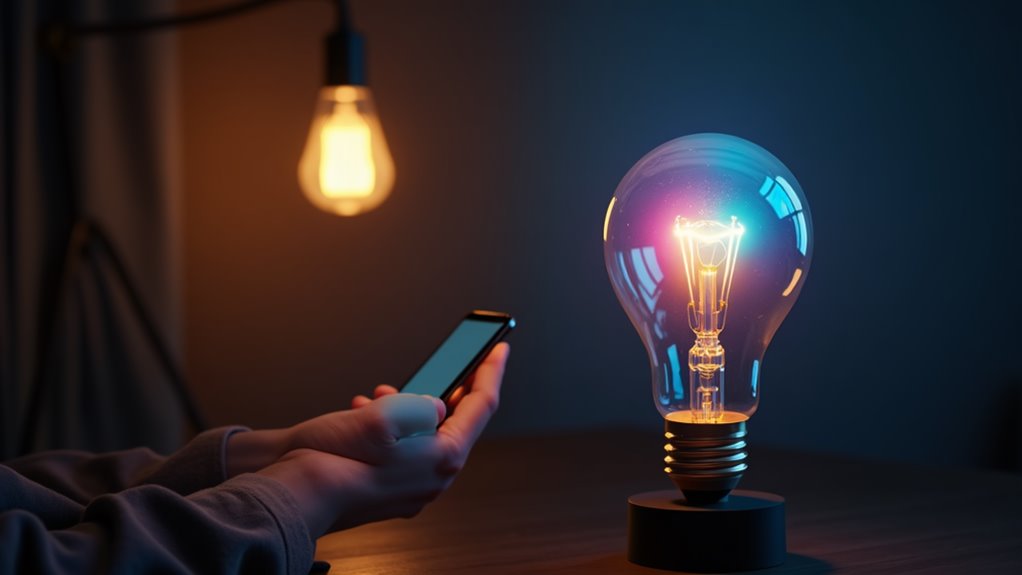
Bài viết cùng chủ đề:
Top 10 Marine LED Navigation Light Bulbs for Boating
Top battery operated LED picture lights to Illuminate art
2025’s Brightest Outdoor LED Bulbs for Safety and Style
Are Clear Light Bulbs Brighter Than Frosted?
Best Security Flood Light Bulbs for Outdoor Protection
Most Energy Efficient LED Light Bulbs to Buy